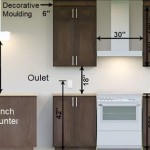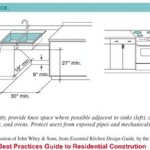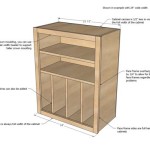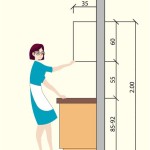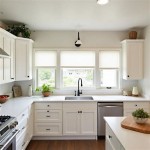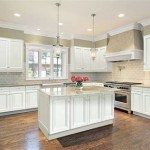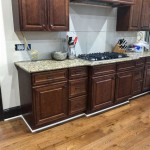How To Redo Kitchen Cabinet Doors: A Comprehensive Guide
Kitchen cabinet doors often bear the brunt of daily wear and tear, accumulating scratches, dents, and outdated finishes. Redoing kitchen cabinet doors presents a cost-effective alternative to replacing entire cabinet systems, allowing homeowners to refresh the aesthetic appeal of their kitchens without a significant financial investment. This article provides a detailed guide on how to effectively redo kitchen cabinet doors, covering the necessary steps from preparation to finishing.
1. Assessment and Planning: Laying the Groundwork
Before embarking on any renovation project, a thorough assessment of the existing cabinet doors is crucial. This involves identifying the type of material the doors are made of (wood, laminate, metal), evaluating the condition of the existing finish (peeling, chipping, fading), and determining the desired outcome. Several factors influence the choice of redoing method, including the material composition of the door, the extent of damage, and the desired aesthetic. For instance, solid wood doors offer more versatility in terms of refinishing options compared to laminate doors, which may be limited to painting or refacing.
Planning also encompasses selecting the appropriate tools and materials. This can include items such as sandpaper (various grits), cleaners, degreasers, primer, paint, brushes, rollers, spray equipment, wood filler (if necessary), masking tape, drop cloths, and safety gear like gloves and eye protection. The choice of paint or stain depends on the desired look and the existing door material. Latex or acrylic paints are commonly used for painted finishes, while stains are chosen to highlight the natural grain of wood. Oil-based paints offer greater durability but require more careful application and longer drying times.
Finally, it's helpful to create a project timeline and budget to ensure the process remains organized and stays within financial constraints. Consider allocating sufficient time for each stage, including preparation, sanding, priming, painting/staining, and drying. This proactive approach will help minimize delays and ensure a professional-looking result.
2. Preparation: The Key to a Flawless Finish
Proper preparation is paramount for achieving a durable and aesthetically pleasing finish on cabinet doors. This stage involves removing the doors from the cabinet frames, cleaning them thoroughly, and preparing the surface for paint or stain.
The first step is to carefully remove the cabinet doors, using a screwdriver to detach the hinges from both the door and the cabinet frame. Labeling each door and its corresponding hinge is essential to ensure proper reinstallation. After removal, thoroughly clean the doors using a degreaser or a mixture of warm water and dish soap. This removes grease, dirt, and other contaminants that can interfere with paint adhesion. Rinse the doors thoroughly and allow them to dry completely.
Sanding is a critical step in preparing the surface. For previously painted or stained doors, sanding removes the existing finish and creates a smooth surface for the new coating. Start with a coarser grit sandpaper (e.g., 80-120 grit) to remove the bulk of the old finish, then gradually move to finer grits (e.g., 220 grit) to smooth the surface. Always sand in the direction of the wood grain to avoid scratching. For laminate doors, sanding should be gentle to avoid damaging the underlying material. A light scuff sanding with a fine-grit sandpaper is often sufficient to promote paint adhesion.
After sanding, remove all sanding dust with a vacuum cleaner, followed by a tack cloth. Any remaining dust particles can create imperfections in the final finish. Inspect the doors for any dents, scratches, or imperfections. Fill these imperfections with wood filler, following the manufacturer's instructions. Allow the wood filler to dry completely, then sand it smooth to blend with the surrounding surface.
Masking off areas that should not be painted or stained, such as the inside of the cabinet door or any decorative panels, is crucial. Use painter's tape to create clean, sharp lines and protect these areas from unwanted paint or stain.
3. Painting and Staining: Applying the New Finish
Once the cabinet doors are properly prepared, the application of the new finish can begin. The choice between painting and staining depends on the desired aesthetic and the type of material the doors are made of.
If painting, apply a primer coat to the prepared surface. Primer serves several important functions: it seals the surface, promotes paint adhesion, and provides a uniform base for the paint. Choose a primer that is compatible with the type of paint being used. Apply the primer in thin, even coats, using a brush, roller, or spray equipment. Allow the primer to dry completely according to the manufacturer's instructions.
After the primer has dried, apply the paint. For a smooth, professional finish, apply multiple thin coats of paint rather than one thick coat. Allow each coat to dry completely before applying the next. Use a high-quality brush or roller for best results. If using spray equipment, be sure to follow the manufacturer's instructions and maintain a consistent distance from the surface.
If staining, apply the stain evenly to the prepared surface using a brush, cloth, or foam applicator. Allow the stain to penetrate the wood for the recommended amount of time, then wipe off any excess stain with a clean cloth. The longer the stain is left on the wood, the darker the resulting color will be. Apply multiple coats of stain to achieve the desired color depth. Allow each coat to dry completely before applying the next.
After the paint or stain has dried completely, apply a topcoat. The topcoat protects the finish from scratches, dents, and other wear and tear. Choose a topcoat that is compatible with the type of paint or stain used. Apply the topcoat in thin, even coats, using a brush, roller, or spray equipment. Allow the topcoat to dry completely according to the manufacturer's instructions.
4. Reinstallation and Hardware: Completing the Project
The final stage involves reattaching the cabinet doors to the cabinet frames and installing new or refurbished hardware. This step completes the transformation and brings the project to fruition.
Carefully reattach the hinges to the cabinet doors and the cabinet frames, using the labeled hinges and doors to ensure proper alignment. Use a screwdriver to tighten the screws securely. If the screw holes are stripped, use wood glue and toothpicks to fill the holes before reinserting the screws.
Install new hardware, such as knobs, pulls, or handles, or refinish the existing hardware. New hardware can significantly enhance the aesthetic appeal of the cabinet doors. If refinishing existing hardware, clean it thoroughly, remove any rust or corrosion, and apply a new finish, such as paint or metal polish.
Inspect the cabinet doors to ensure they are properly aligned and functioning smoothly. Adjust the hinges as needed to ensure the doors open and close properly. Check for any gaps or inconsistencies in the finish and touch up any imperfections with paint or stain.
Clean the surrounding area, removing any masking tape, drop cloths, and other materials. Dispose of any leftover paint, stain, or other materials according to local regulations.
Allow the paint or stain to fully cure, which may take several days or weeks, depending on the type of finish used. Avoid touching or cleaning the cabinet doors during the curing process to prevent damage or imperfections.
By following these steps, homeowners can effectively redo their kitchen cabinet doors, transforming their kitchens into stylish and functional spaces without the expense of replacing entire cabinet systems. The result is a refreshed kitchen with a personalized touch, reflecting the homeowner's taste and style.

How To Update Kitchen Cabinet Doors On A Dime My Blessed Life

Kitchen Diy Shaker Style Cabinets Cherished Bliss

21 Diy Affordable Ways To Redo Kitchen Cabinets Extra Space Storage

How To Update Kitchen Cabinet Doors On A Dime My Blessed Life Cabinets Makeover

21 Diy Affordable Ways To Redo Kitchen Cabinets Extra Space Storage

How To Paint Kitchen Cabinets In 7 Simple Steps

15 Diy Kitchen Cabinet Makeovers Before After Photos Of Cabinets

10 Simple Ideas To Update Your Kitchen Cabinets Jenna Sue Design

Diy Inexpensive Cabinet Updates Kitchen Cabinets Makeover Renovation

How To Build Cabinet Doors Update Your Cabinets Or Built Ins
Related Posts


